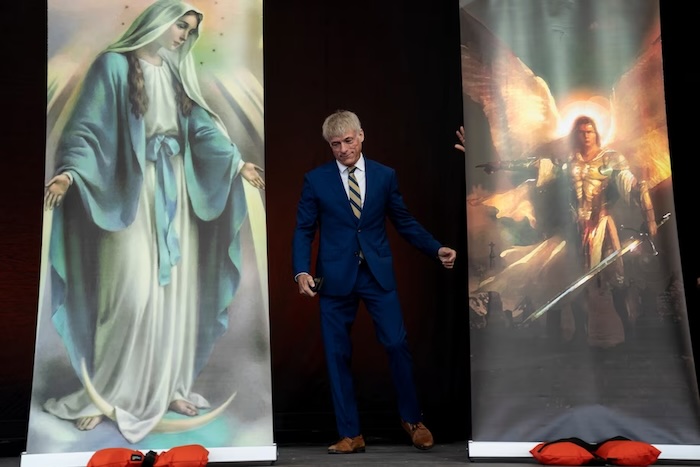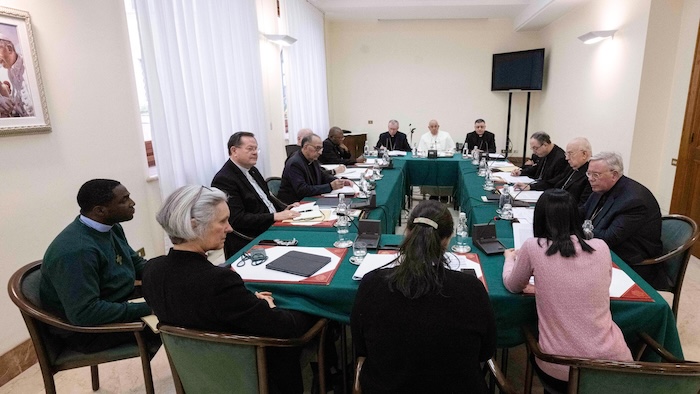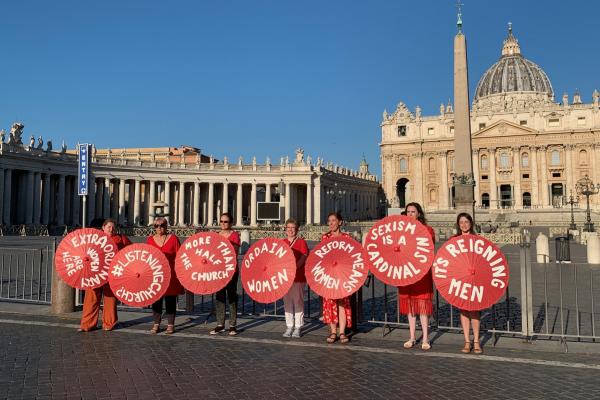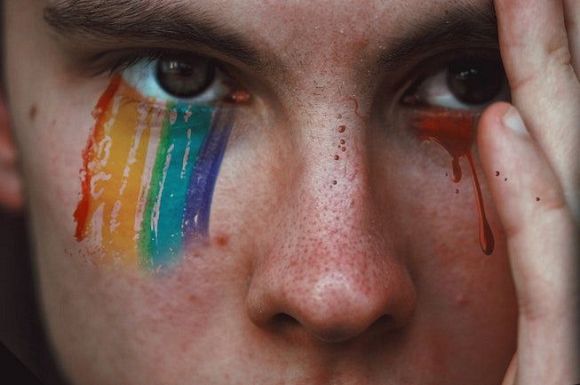— Staffers say he sent them racy selfies.

At the far-right Church Militant, Michael Voris accused liberal Catholics and others he opposed of being gay until he resigned over unspecified ‘morality’ concerns. Staffers now say he had shared shirtless gym photos.
By Will Sommer
In his 17 years as a self-appointed enforcer of what he viewed as traditional Catholicism, Michael Voris developed a go-to strategy for taking on his targets: accusing them of being gay.
The head of far-right website Church Militant, Voris often claimed the Catholic church was secretly run by an “international gay-crime syndicate.” In a 2020 webcast, he referred to the Black archbishop of Washington as a term many viewed as both a racial and gay slur, provoking an outraged backlash from church scholars and officials.
“Are you homosexual, yes or no?” Voris demanded in 2017 on a typical episode of his online show, in which he monologued furiously about a prominent Jesuit priest with liberal political beliefs. A year earlier, Voris had floridly repented for his own past relationships with men, calling homosexuality abhorrent.
Over the past decade, Church Militant also waged war on secular liberals and moderate Catholics, but most emphatically on LGBTQ+ people and causes. It was Voris’s platform for publicizing photos of a gay church employee in San Diego with his husband after they were already facing harassment, and raising money to support a priest who was removed from his job after burning a rainbow banner. Church Militant had more than 300,000 YouTube subscribers, dozens of employees, and listed $3.6 million in annual revenue in its 2022 tax filings — thanks in large part to donations raised by its charismatic founder.
Then it all came crashing down. In November, Voris resigned over what his board described as a breach of Church Militant’s “morality clause,” with no other public explanation of his offense.
Interviews with staff and documents viewed by The Washington Post, though, reveal that employees had complained that Voris had sent shirtless workout photos of himself to Church Militant staff and associates.
Voris’s trouble began April, when strange images appeared on Church Militant’s cloud-storage account, according to several staff members: shirtless selfies of Voris, some of them cut off just above his pelvis, along with a screenshot of a text-message exchange screenshot from someone expressing that they found the images sexually arousing.
On a Dropbox account typically reserved for matters such as the syllabus for an online class about the book of Ephesians, these new images stood out. Employees speculated that they had been uploaded unintentionally from Voris’s phone along with business documents meant for staff viewing.
Voris and Church Militant did not respond to requests for comment. Days after his resignation, several staffers were laid off and escorted out of their suburban Detroit offices. In a Dec. 15 email to supporters, its board acknowledged Voris was embroiled in an unspecified “scandal,” and said it has launched an independent audit of his financial management.
Voris is a former local television reporter who was raised Catholic but committed himself more deeply to the faith after his mother died of cancer 20 years ago, he has said. In 2006, he launched Church Militant under the name “Real Catholic TV” — a name it kept until 2011, when the Archdiocese of Detroit asked the fractious outlet to drop “Catholic” from its name.
It found its footing in a conservative strain of American Catholicism rebelling against Pope Francis’s liberalization efforts — especially recent measures signaling greater acceptance of LGBTQ+ people, such as granting permission for priests to bless same-sex couples. In 2014, Voris railed against a decision to allow gay organizations to march in Boston’s St. Patrick’s Day Parade and fumed a year later after openly gay comedian Mo Rocca delivered a reading at a mass officiated by Francis in New York.
“He was convinced that everything had to be destroyed in the Catholic Church in order for everything to be rebuilt,” said Alejandro Bermudez, the former head of Catholic News Agency, now a consultant for Catholic media outlets, who described Voris as a “flamethrower.”
Church Militant hit a new level of prominence after what some Catholics have dubbed the 2018 “Summer of Shame,” when the church was deluged with new sexual abuse allegations. Voris ratcheted up his attacks on issues of sexuality.
“He knew he was going to get eyeballs on content that was controversial in nature,” said Marc Brammer, an early Church Militant investor who has since distanced himself from Voris.
>And as a supporter of then-president Donald Trump, Voris bolstered his profile with other conservative figures. Trump adviser Stephen K. Bannon hailed him as a “fighter,” and he hosted friendly interviews with MAGA power players like Rep. Marjorie Taylor Greene (R-Ga.) and American Conservative Union head Matt Schlapp.
But Voris’s own personal history frequently complicated his stance on gay people. In 2016, he publicly acknowledged on his show that, decades earlier, he had lived an “extremely sinful” life of “live-in relationships with homosexual men.” Voris said the admission was meant to preempt attacks from his enemies within the church and that he was no longer in sexual relationships with men, having come to “abhor all these sins.”
Voris kept up his attacks on LGBTQ+ people even after his admission about his own past, and Church Militant continued to grow. But the workout selfies brought old questions about Voris’s sexuality back to the surface — in addition to raising concerns about workplace harassment — for a conservative cohort that largely disapproves of homosexuality, according to ex-employees and three letters from staffers to Church Militant’s board that were reviewed by The Post.
Former employees told The Post that the dozens of shirtless images that showed up in the office Dropbox account appeared to have been uploaded accidentally, and that someone at the organization took quick steps to shut down access.
In early November, fellow Church Militant webcast host Christine Niles warned the board that Voris had also sent pictures directly and apparently intentionally to other men, including some of his employees. (In April, a rival personality on far-right Catholic Twitter had already called out Voris for his alleged selfie-sharing habit, posting an image he had obtained of Voris photographing himself shirtless at a gym and asking why the Church Militant leader was sending “half-nude selfies to his young, single male employees.”)
“I’ve learned Michael has been in the habit of sending shirtless selfies to multiple men inside and outside the apostolate,” Niles wrote in the letter, announcing her resignation, a copy of which was reviewed by The Post. “They reveal an unhealthy obsession with his physique, not to mention the terrible optics — particularly considering his former lifestyle.” She also warned that copies of the photos still existed on employee hard drives, posing the risk of a scandal.
A group of Church Militant employees sent their own unsigned letter to the board that same month, complaining that Voris had sent a selfie to a prominent potential donor that they believed had cost them a sizable contribution, according to a copy reviewed by The Post.
In a separate letter to Church Militant’s board also viewed by The Post, ex-employee Hunter Bradford said there was a “cult” of fear around Voris at the office.
Niles and Bradford did not respond to requests for comment.
“I don’t know if it was a gym bro thing or what,” Joe Gallagher, a former Church Militant employee, told The Post. (Gallagher quit in November 2022 after he said Voris accused him of plotting a coup against him.) “A whole bunch of young guys got them, I know that.”
After Voris resigned, Church Militant sold two of its office buildings in late December, according to court records. But the organization remains in financial jeopardy. A lawsuit from a priest suing Church Militant for defamation in New Hampshire is scheduled for trial in March.
In its December fundraising email, the board said that “the Evil One” had taken a “huge bite” out of the company, suggesting the whole outlet could collapse without more donor support.< “We would hate to lose this place to the Devil,” the fundraising email read. Yet after years of Voris’s scorched-earth tactics and dancing around controversy, few of Church Militant’s old supporters seem to be mourning the loss of its leader. “Nobody is saying ‘Oh, what a shame, so sad,’” said Bermudez, the Catholic-media consultant. “Nobody, not one.” Complete Article ↪HERE↩!






